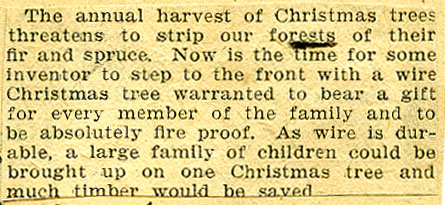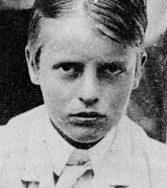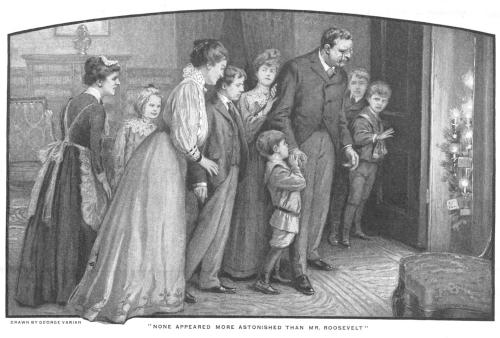President bans Christmas tree from White House!
(First published in 2008, this blog posted was updated in 2012 and, after finding the letters to his sisters on the Theodore Roosevelt Center’s website, again in 2016 and 2019.)
Around the internet, there are innumerable articles about how Theodore Roosevelt banned Christmas trees in the White House because of “environmental concerns” only to then have one of his sons rebel and install a small tree, much to his father’s surprise. There’s even an episode of Drunk History about it. There are variations on the story about the ban. Some versions of the story include a confrontation between father and son. Some have the children enlisting Gifford Pinchot, the federal chief of forestry, to defend their actions. The incident is even the subject of a children’s book by Gary Hines which, along with the internet, is helping perpetuate this myth. But no biography of Roosevelt, or his wife, or his autobiography, or any of Gifford Pinchot, mention this incident. So what really happened?
While the Roosevelts’ lack of a tree was not a complete break in tradition—a holiday tree in the White House did not become established annual practice until the 1920s—it was still a notable exclusion. Prior to Roosevelt, Christmas trees infrequently appeared in the White House. Legend has it that the fifteenth president, James Buchanan, decorated the first tree on the White House lawn, but even that is disputed, with some sources saying Franklin Pierce had the first one in 1853. (Keep in mind that as late as the 1840s, most Americans viewed Christmas trees as pagan symbols; the day itself was treated with great solemnity. Bringing trees into the home to decorate wouldn’t catch on until after the U.S. Civil War.)
Nevertheless, nineteenth-century American households typically didn’t put one up unless there were young children in the house; they placed the presents under or even on the tree for the tykes. Presidents Grant and Cleveland both had Christmas trees in the White House only because they had young children, while presidents without young children had no tree. Interestingly, on their website, the White House Historical Association claims that in 1889, Benjamin Harrison was the first president to have a Christmas tree (he did have one, for his grandchildren). But the site makes no mention of any before then. It also states that electric lights were first used on a Christmas tree in 1894.
Regardless of which president had the first White House Christmas tree, by the time of Roosevelt’s presidency, opposition to having natural Christmas trees was peaking. In the years immediately before he took office in 1901, Congress had passed the Forest Reserve Act in 1891 and the Forest Management Act in 1897, putting the federal government in charge of national forests carved from public lands. (These forests weren’t supplying Christmas trees.) Then Gifford Pinchot was appointed chief of the U.S. Division of Forestry in 1898 and soon made forest conservation a national cause.
In 1899, President William McKinley was reported by the Chicago Daily Tribune to have received “many letters…begging Mr. McKinley to refuse to have a Christmas tree.” The reason to do so, the letter writers argued, was “to discourage this practice of arboreal infanticide.” Other arguments included opposition to cutting trees for the holiday because of the injurious impact on forests, the destructive methods used to harvest them, or the overall perceived wastefulness of the practice.
The U.S. Forest Service Newsclipping Files in the FHS Archives contain numerous newspaper editorials from around the turn of the century strongly challenging the practice. The Hartford Courant in 1902 commented that “the green has become a nuisance, there is so much of it. Everything from a church to a saloon has to be decorated. The result is that the woods are being stripped and an altogether endless sacrifice is going on, not in obedience to any real need but just to meet the calls of an absurd fad.” In what sounds like the debates over natural versus artificial trees today, others called for artificial substitutes such as wire Christmas trees:

President Roosevelt himself was on record as opposing destructive lumbering practices, though he doesn’t appear to have singled out the practice of harvesting Christmas trees. It is worth noting that Chief Forester Pinchot actually saw nothing wrong with the practice, and by 1907 was even urging the creation of businesses specifically for growing them. He even claimed that the four or five million trees needed could be grown on 1,600 acres.
A few contemporary newspaper articles note how family tradition held that the Roosevelts never had one. However, in 1901, the Baltimore Sun said that the family had had a tree at their Oyster Bay, New York, home but couldn’t have one in the White House because all the public rooms were in constant use and the private quarters too cramped. Nevertheless, each year the press enjoyed speculating about whether the family would have a tree. It was expected that Roosevelt—the father of six children—would have a tree in the White House. What happened in 1902 made the news, however, and soon passed into legend.

Archie Roosevelt – The Child, The Myth, The Legend!
This much we know for certain: in 1901, having moved into the White House only a few months before Christmas following the assassination of McKinley, the Baltimore Sun reported in a special dispatch that the Roosevelt children couldn’t enjoy a tree because of the “cramped quarters,” so they instead “must” have it at their cousins’ house. The newspaper also reported that Roosevelt played the role of Santa Claus, something he’d been doing for several years in his hometown of Oyster Bay, and wore his Rough Rider outfit while handing out presents. So, clearly the president enjoyed Christmas and several of its traditions. And we know the family’s first Christmas in the White House passed without a tree.
In 1902, Roosevelt, in a letter written the next day to a friend of the children’s, described how his eight-year-old son Archie “had a little birthday tree of his own which he had rigged up” in a big closet with help from “one of the carpenters.” There’s no mention of lights—that’s only implied when saying the tree was “rigged up.” Archie decorated it with gifts for each family member and even the family pets. Afterward, they adjourned to another room where everyone opened their presents. Roosevelt discussed the tree but did not offer a reaction to it.
Yet, with that tree, it seems that Archie may have begun a family tradition. In a letter to his sister Corrine Robinson penned on December 26, 1906, the president writes:
“Archie and Quentin have gradually worked up a variant on what is otherwise a strictly inherited form of our celebration, for they fix up (or at least Archie fixes up) a special Christmas tree in Archie’s room, which is the play-room; and the first thing we had to do was to go in and to admire that. Meanwhile, two of the children had slipt [sic] out, and when we got back to our room there was a small lighted Christmas tree with two huge stockings for Edith and myself, the children’s stockings (which included one for [son-in-law] Nick) reposing, swollen and bulging, on the sofa.”
On Christmas Day in 1907, in a letter written to his sister Anna Cowles, whom he called “Bye,” he mentions in passing that on that afternoon, following a full day of horseback riding and visiting friends, “there was a Christmas tree of Archie’s.” The comment was offered so casually that it appears that Archie having a tree was not only not a surprise, but that it was expected. This might explain why the children had provided a tree especially for their parents the year before—to surprise them once again as they had in 1902.
Newspaper articles from 1903 to 1908 mention that there will be no tree that year but speculate about what will happen and if Archie will “pull a fast one.” Some articles from 1903, 1904, and 1905 claim Archie had a secret tree each of those years, with the writers essentially repeating the events of 1902 as if it just happened for the first time. Oddly, the articles are dated December 24th or even the 25th. But, as previously stated, we know for certain that Archie did have a tree in 1906 and 1907, and that from President Roosevelt’s letter in 1906 we can infer that Archie had one in the years between 1903 and 1905.
The first lengthy account of Archie’s first tree appears in a December 1903 Ladies Home Journal article written by Robert Lincoln O’Brien, former executive clerk (stenographer) at the White House in the Cleveland years who became a prominent journalist afterward. Roosevelt respected O’Brien, a fellow Harvard man, whom Roosevelt felt always told the truth. Remember, this was the age of yellow journalism and muckraking. So this was high praise coming from a major critic of the press.
In his account of the events of Christmas 1902, O’Brien first notes that the family traditionally didn’t have a tree. He claims that Quentin’s nurse suggested enlisting the household electrician to rig up lights. He next recounts the unveiling of the tree, which was the top of an evergreen no more than two feet high and purchased for twenty cents by a White House employee. He quotes Archie as saying at the time of the unveiling, “Just look here for a minute. I want you to glance into this old closet,” before pressing a button to turn on the lights and opening the closet door. O’Brien wrote, “All the family were there, as was Quentin’s nurse, but none appeared more astonished than Mr. Roosevelt himself at the sight of this diminutive Christmas tree.”

From Robert Lincoln O’Brien’s article in Ladies Home Journal.
O’Brien also addresses the rumors as to why the Roosevelt family didn’t have a tree in previous years. He says some speculated that “the President’s love for the living things of the forest in their own natural setting” was so great “that he prefers not to encourage the wanton slaughter of small trees.” O’Brien summarizes the debate over “the Christmas-tree practice” as being between those who believe “that trees are made for the use and enjoyment of man” and “man might as well pick out what he wants,” versus those who believe that “best-shaped trees” are the ones selected for holiday harvest and “are the very ones that the world can least afford to lose.” Instead, he writes, the issue for the First Family was a matter of personal preference. The family was so large, and with nearly every room in the White House “overloaded with things” during the holiday season, displaying trees “would only add so much more.” Rather, Mr. and Mrs. Roosevelt desired to enjoy Christmas as simply as possible.
For some in the press, the environmental arguments circulating in 1902 soon became the reason for the rumored presidential ban, despite such explanations to the contrary. In a December 1909 article in the Oregonian about the history of Christmas in the White House, the motive for banning the Christmas tree, in language that closely echoes O’Brien, is linked to “the wanton destruction of small evergreen trees at Christmas time.” But then, the reader is told, “Mr. [Gifford] Pinchot, the Government’s chief forester, sided with Santa Claus and showed how Christmas tree cutting did the forests good in many places. So the second [w]inter the Roosevelts spent in the White House Old Kris conspired with roguish Archie to give the family a real Christmas tree, whether the nature-loving President liked it or not.” Here, for the first time, Forest Service Chief Gifford Pinchot is drawn into the drama—and sides with the children by discussing the benefits of selection cutting. This author is vague about who Pinchot lectures on the topic, but the message gets through to the President and he relents in the face of science. The problem with this is that Pinchot was on a ship in the middle of the Pacific, returning from Asia during the 1902 Christmas season. He’d left in September and didn’t return until January 8, 1903. Archie couldn’t have consulted with him, even if he wanted to.
Fast-forward 80 years, and the story is twisted even further and becomes almost fantasy. In a December 1988 article in The Northern Logger and Timber Processor, Dick O’Donnell introduces several errors (for starters, the story occurs in 1905, and he claims that this incident started the White House Christmas tree tradition) and veers so far to fiction that I won’t even bother further deconstructing and critiquing his account. But O’Donnell does spin a great yarn. He tells us with a straight face that in 1905, Archie has the idea for the tree but Quentin is worried by their father’s ban on trees. Archie’s solution is to pay Forester Pinchot a visit and enlist the president’s friend and adviser for help. He not only sides with them, but then Pinchot proceeds to teach President Roosevelt about selective cutting. The president then calls a press conference to announce a change in forest management policy on federal lands, which—really—is just a ludicrous assertion if you know your conservation history. Roosevelt and Pinchot had been discussing the matter since Roosevelt was governor of New York, if not longer. But perhaps the conversations O’Donnell conjures up between Archie and Quentin, and between Roosevelt and Pinchot, gave Gary Hines the inspiration for his wonderful children’s book. So it can’t be all bad.
We are trying to answer the following questions: How, why, and when did the crux of the legend that Roosevelt banned trees from the White House due to environmental concerns come to be accepted as gospel? Did Roosevelt ever oppose the Christmas tree due to concern for America’s forests, or is this a case of revisionist history? In other words, when the legend becomes fact, print the legend?

